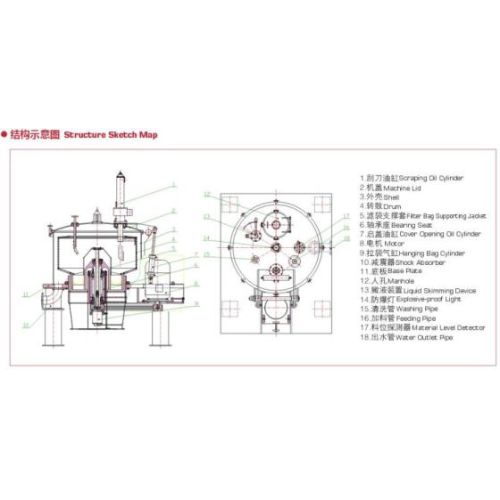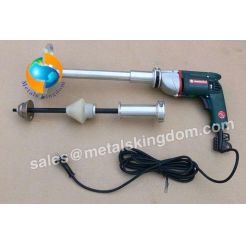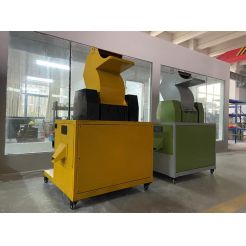Industrial Centrifuge Separator Working Principle
Product Description
Min Order Quantity:1 Set
Supply Ability:3500sets per year
Delivery Lead Time:120days
Country/Region:China
City:Jingjiang
Product Attributes
- - Place of Origin China
- - Supply Type OEM Service
- - Condition New
- - Related Keywords centrifugal separator
Description by Manufacturer
INDUSTRIAL CENTRIFUGE SEPARATOR WORKING PRINCIPLE
The industrial centrifuge working principle is fed tangentially to the cylindrical top of the centrifugal separator to produce rotation. Through the slot in the air inlet chamber, the flow rate in industrial centrifuge is further accelerated. Centrifugal force moves the heavy particles to the side of the barrel. They move down and accumulate in the collection chamber at the bottom of the separator. The deflector at the top of the collection chamber changes the flow direction. No solid liquid moves upward in the vortex and exits through the top of the separator. The separated solids are removed from the collection chamber periodically or continuously.
What Is Centrifugation And Where It Is Used?
The centrifugal separator is driven by centrifugal technology. Centrifugation uses centrifugal force to separate particles from solution. This process is mainly used to separate two immiscible substances in the solution. Centrifuge is mainly used to separate solid particles from liquid in suspension; or to separate two immiscible liquids with different densities in emulsion (such as separating cream from milk); it can also be used as solid liquid centrifugal separator, such as drying wet clothes with a washing machine; special ultra-fast tube separators can also separate gas mixtures of different densities, such as enrichment and separation of gaseous uranium hexafluoride; Due to the characteristics of different sedimentation speeds in the liquid, some sedimentation centrifuges can also classify solid particles according to density or particle size. The centrifuge separator is widely used in chemical, petroleum, food, pharmaceutical, mineral processing, coal, water treatment and shipbuilding sectors.
Centrifugal Separator Working Principle
Centrifuge separator machine has a high-speed rotating cylinder, called a bowl, around its axis, usually driven by an electric motor. After the suspension (or emulsion) is added to the drum, it is rapidly driven to rotate at the same speed as the drum, and the components are separated and discharged separately under the action of centrifugal force. In general, the higher the drum speed, the better the separation effect. There are two types of centrifuge separators: centrifugal filtration and centrifugal sedimentation. Hence there are two industrial centrifuge working principles.
(1) Centrifugal filtration
The centrifugal pressure generated by the suspension under the centrifugal force field acts on the filter medium (filter screen or filter cloth), so that the liquid passes through the filter medium to become filtrate; while the solid particles are trapped on the surface of the filter medium to form a filter residue, thereby realizing liquid-solid separation. There are holes on the circumferential wall of the filter drum, and the inner wall is lined with filter media, which is centrifugal separator working principle.
(2) Centrifugal sedimentation
Liquid-solid (or liquid-liquid) separation is realized by utilizing the principle of rapid sedimentation and stratification of components with different densities of suspension (or emulsion) in a centrifugal force field. The peripheral wall of the sedimentation drum has no holes. After the suspension (or emulsion) is added to the drum, the solid particles (or liquid with higher density) settle to the drum wall to form a sediment (or heavy separation liquid). The liquid with lower density gathers in the direction of the center of the drum, flows to the overflow port for discharge, and becomes the separation liquid (or light separation liquid). The rotary drum filter is used for intermittent slag discharge, which is suitable for the separation of suspensions or emulsions with small particle size and low concentration of solid particles. In the drum with multi-layer conical discs, the liquid is divided into several thin layers by the discs, which shortens the distance of sedimentation separation, accelerates the separation, and improves the separation effect.
When the solid and liquid mixture to be separated enters the high-speed rotating drum from the feeding port, under the action of centrifugal force, the mixture is filtered through the filter screen, the liquid separation is discharged through the drain pipe, and the solid separation is left in the drum. Inside, when the solid separation in the drum reaches the requirements specified by the equipment, stop feeding, clean the solid separation, and discharge the washing liquid at the same time. After the cleaning meets the requirements, the centrifuge separator runs at a low speed, and the solid separator discharge device (scraper) is driven by the AC servo motor to discharge the solid separator to complete a working process.
As an industrial centrifuge machine manufacturer , we have types of centrifuge machine for sale, if you have any needs, please contact us.
Price
- Price US$ \ 25000 ~ 1100000 / Set
Packaging & Shipping
- - Packingcarton
- - Delivery Lead Time120days
- - Minimum Order 1 Set
- - Supply Ability3500sets per year
- - Total quantity in Stock301 – 500
- - Shipping Career
Product Image
Description by Manufacturer
INDUSTRIAL CENTRIFUGE SEPARATOR WORKING PRINCIPLE
The industrial centrifuge working principle is fed tangentially to the cylindrical top of the centrifugal separator to produce rotation. Through the slot in the air inlet chamber, the flow rate in industrial centrifuge is further accelerated. Centrifugal force moves the heavy particles to the side of the barrel. They move down and accumulate in the collection chamber at the bottom of the separator. The deflector at the top of the collection chamber changes the flow direction. No solid liquid moves upward in the vortex and exits through the top of the separator. The separated solids are removed from the collection chamber periodically or continuously.
What Is Centrifugation And Where It Is Used?
The centrifugal separator is driven by centrifugal technology. Centrifugation uses centrifugal force to separate particles from solution. This process is mainly used to separate two immiscible substances in the solution. Centrifuge is mainly used to separate solid particles from liquid in suspension; or to separate two immiscible liquids with different densities in emulsion (such as separating cream from milk); it can also be used as solid liquid centrifugal separator, such as drying wet clothes with a washing machine; special ultra-fast tube separators can also separate gas mixtures of different densities, such as enrichment and separation of gaseous uranium hexafluoride; Due to the characteristics of different sedimentation speeds in the liquid, some sedimentation centrifuges can also classify solid particles according to density or particle size. The centrifuge separator is widely used in chemical, petroleum, food, pharmaceutical, mineral processing, coal, water treatment and shipbuilding sectors.
Centrifugal Separator Working Principle
Centrifuge separator machine has a high-speed rotating cylinder, called a bowl, around its axis, usually driven by an electric motor. After the suspension (or emulsion) is added to the drum, it is rapidly driven to rotate at the same speed as the drum, and the components are separated and discharged separately under the action of centrifugal force. In general, the higher the drum speed, the better the separation effect. There are two types of centrifuge separators: centrifugal filtration and centrifugal sedimentation. Hence there are two industrial centrifuge working principles.
(1) Centrifugal filtration
The centrifugal pressure generated by the suspension under the centrifugal force field acts on the filter medium (filter screen or filter cloth), so that the liquid passes through the filter medium to become filtrate; while the solid particles are trapped on the surface of the filter medium to form a filter residue, thereby realizing liquid-solid separation. There are holes on the circumferential wall of the filter drum, and the inner wall is lined with filter media, which is centrifugal separator working principle.
(2) Centrifugal sedimentation
Liquid-solid (or liquid-liquid) separation is realized by utilizing the principle of rapid sedimentation and stratification of components with different densities of suspension (or emulsion) in a centrifugal force field. The peripheral wall of the sedimentation drum has no holes. After the suspension (or emulsion) is added to the drum, the solid particles (or liquid with higher density) settle to the drum wall to form a sediment (or heavy separation liquid). The liquid with lower density gathers in the direction of the center of the drum, flows to the overflow port for discharge, and becomes the separation liquid (or light separation liquid). The rotary drum filter is used for intermittent slag discharge, which is suitable for the separation of suspensions or emulsions with small particle size and low concentration of solid particles. In the drum with multi-layer conical discs, the liquid is divided into several thin layers by the discs, which shortens the distance of sedimentation separation, accelerates the separation, and improves the separation effect.
When the solid and liquid mixture to be separated enters the high-speed rotating drum from the feeding port, under the action of centrifugal force, the mixture is filtered through the filter screen, the liquid separation is discharged through the drain pipe, and the solid separation is left in the drum. Inside, when the solid separation in the drum reaches the requirements specified by the equipment, stop feeding, clean the solid separation, and discharge the washing liquid at the same time. After the cleaning meets the requirements, the centrifuge separator runs at a low speed, and the solid separator discharge device (scraper) is driven by the AC servo motor to discharge the solid separator to complete a working process.
As an industrial centrifuge machine manufacturer , we have types of centrifuge machine for sale, if you have any needs, please contact us.
Price
- Price US$ \ 25000 ~ 1100000 / Set
Packaging & Shipping
- - Packingcarton
- - Delivery Lead Time120days
- - Minimum Order 1 Set
- - Supply Ability3500sets per year
- - Total quantity in Stock301 – 500
- - Shipping Career


